This article is about the rolling stock of the Bluebell Railway.
Steam locomotives
Operational
[1]
| Origin |
Wheel
arrangement |
Class |
Notes |
Photograph |
| BR |
4-6-0 |
5MT |
No 73082 Camelot. Built in 1955. Arrived at Bluebell 1979, and owned by the 73082 Camelot Locomotive Society. The locomotive returned to service following its latest overhaul in October 2015. Its owners plan to run it for a period of time without its nameplates, as it did prior to being named in 1959. Boiler ticket expires in 2025. |
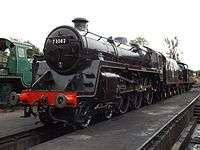 |
| SR |
0-6-0 |
Maunsell Q Class |
No 30541. Built in 1939. Arrived at Bluebell 1978. Owned by the Maunsell Society.[2] The volunteer Loco Workshop Working Group carried out the overhaul of the loco, beginning in July 2011. The locomotive returned to service in April 2015 after a few minor problems emerged and were rectified following initial completion. Boiler ticket expires in February 2025. |
 |
| SR |
4-6-0 |
S15 |
No 847. Built in 1936. Arrived at Bluebell 1978 and owned by the Maunsell Locomotive Society.[3] It returned to service following its latest overhaul in December 2013 after being out of service for 16 years. The loco is now a stable member of the running fleet after numerous adjustments and repairs especially to its regulator control rod. Boiler ticket expires in November 2023. |
 |
| SE&CR |
0-4-4T |
Class H |
No 263. Built in 1905. Arrived at the Bluebell in 1976, and returned to traffic after its latest overhaul in July 2012. Initially some light repairs to the axleboxes delayed the locomotive entering regular service, but these issues have now been fixed and mean 263 is now a stable member of the fleet. Boiler certificate expires in May 2022. |
.jpg) |
| SE&CR |
0-6-0T |
Wainwright P Class |
No 323 Bluebell. Built in 1910. Arrived at the Bluebell in July 1960 as the second locomotive purchased from British Railways. The locomotive returned to steam in March 2011, painted in its unique 'Bluebell Blue' livery. Boiler certificate expires in 2021. |
 |
| Fletcher Jennings |
0-4-0T |
|
No. 3 Baxter. Built in 1877. Named after the chairman of the famous soup company and painted in a colour to match the cream of tomato variety of that company. Arrived at the Bluebell in August 1960. The engine returned to steam in August 2010 and is frequently used for shunting and for various tasks around the line. Baxter was fitted with vacuum brakes during 2011 to enable its solo use on passenger stock for the first time. In 2014 the engine starred in the movie Muppets Most Wanted, known as Randy Stevenot No. 3 with some American attachments. In July 2016, Baxter was invited to the Talyllyn Railway to celebrate Dolgoch's 150th birthday and becoming the first standard gauge engine to visit the railway. Boiler ticket expires in July 2020. |
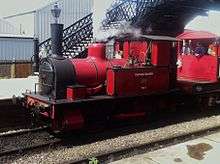 |
| SE&CR |
0-6-0T |
Wainwright
P Class |
No 178. Built in 1910. Arrived at the Bluebell in 1969. Returned to traffic on 27 February 2010 following extensive overhaul. The locomotive has been restored to full SECR goods livery and occasionally carries the name Nettle the Kettle (a reference to the names of the other P class tanks based on the line Bluebell and Primrose). Sadly in late 2014 after four years in ticket the locomotive failed with issues with its cylinder block after a repair which failed it was found that the cylinder block has the same crack since when it arrived in 1969. 178 is now on light duties only but is in service. Boiler certificate expires in February 2020. |
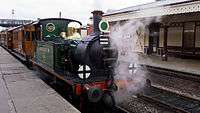 |
| SE&CR |
0-6-0 |
Wainwright C Class |
No 592. Built in 1902. Arrived at Bluebell 1970. Last restored in 2007. 592 was prematurely withdrawn from traffic in September 2012 due to a lack of power resulting in the fitting of a new cylinder liner, and a return to service was made in August 2013. A further withdrawal was made in late 2014 for boiler repairs to be carried out, and 592 returned to service in April 2015. The locomotive is currently in restricted usage following the discovery of worn flanges. Boiler ticket expires in 2017. At its next overhaul it will require new tyres, a new cylinder block and a new copper firebox. |
 |
|
Undergoing overhaul, repair or restoration
[4]
| Origin |
Wheel
arrangement |
Class |
Notes |
Photograph |
| SR |
4-6-2 |
Rebuilt Bulleid Light Pacific |
No 34059 Sir Archibald Sinclair. Built in 1947. Arrived at Bluebell 1979. Relaunched and renamed on 24 April 2009, and entered public service the following day, after a 10-year rebuild from Barry condition. 34059 was the first rebuilt Battle of Britain Class locomotive to steam in preservation. 34059 was withdrawn from traffic in October 2011 with firebox problems. Remedial work on the boiler (thought to take around nine months) has commenced with the boiler being lifted and taken to Crewe for work to commence. Once this work has been completed the engine should return to traffic quickly, with a new 10 year boiler ticket.[5] In early 2016 it was discovered the locomotive needed a new inner firebox, and the boiler has been transferred to the South Devon Railway for work to be undertaken. |
 |
| BR |
2-6-4T |
Standard 4 Tank |
No 80151. Built in 1956. Arrived at Bluebell 1998. Returned to traffic in 2001. The engine was withdrawn prematurely in late 2010 with leaking tubes.[6] Boiler repairs were carried out in early 2011 and the locomotive returned to service. 80151 was finally withdrawn from traffic in May 2012 following expiry of her boiler ticket. Work began on overhauling the loco in September 2015 as 73082 Camelot was being completed. New tyres need fitted to the driving wheels, however the boiler is believed to be in very good condition. |
 |
| SECR |
0-6-0 |
O1 Class |
No 65. Built in 1896. Boiler ticket expired on 7 July 2009. The locomotive is seen as a reliable and remarkably powerful performer, as well as one which will complement the other SE&CR engines currently in traffic. In August 2013, it was announced that the boiler (actually a spare H class boiler) would be sent away for overhaul, speeding up the restoration process which began in June 2016. |
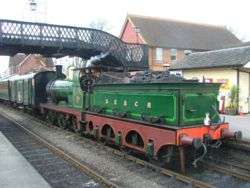 |
| SR |
4-4-0 |
Schools |
No 928 Stowe. Built in 1934. Arrived at Bluebell 1980. Last worked in 1991. Owned by the Maunsell Locomotive Society. An examination of the locomotive has shown that a new inner firebox will be required at a cost of up to £75,000. 928's tender has undergone a major rebuild in recent years. The boiler tubes, cab fittings & smoke deflectors have been removed prior to overhaul. The boiler is currently being worked on in the locomotive workshops and with 30541 complete work is expected to advance quickly. |
 |
| SE&CR |
0-6-0T |
Wainwright P Class |
No 27 Primrose. Built in 1910, last worked in 1974. Arrived at Bluebell 1961. An overhaul was prepared and started in 1978 with the loco being dismantled, but it was paused for over 30 years due to the overhaul and maintenance of other locomotives before being restarted in 2012. This is likely to be a long term overhaul similar to those carried out on 672 and 178 due to the poor condition of the locomotive, it having been stored in pieces for many years. It is hoped to have the locomotive in steam in time for the 100th Anniversary of the end of The First World War in 2018. |
 |
| BR |
2-6-2T
(was
2-6-0) |
Standard Class 2 |
No 84030 (formerly 78059). Recovered from Barry Scrapyard without a tender in 1980. the tank version of this design was a typical BR(S) engine. None of the original Standard Class 2 tank engines (84000-84029) survives, so this conversion will create the sole representative of the class. Reconstruction as a tank engine is well under way, with work currently focused on the frames, to which the new extension has now been welded. It is hoped the loco will be finished by 2018/2019. |

 |
|
Under construction
| Origin |
Wheel
arrangement |
Class |
Notes |
Photograph |
| LB&SCR |
4-4-2 |
H2 |
A replica of No 32424 Beachy Head (Brighton, 1911) is under construction at Sheffield Park. Work on the frames is currently under way with new holes being drilled into the tender frames. Re-tubing of the boiler is also in progress. As of April 2013 the cylinders, bogie and trailing wheels had been fitted and the driving wheels had been delivered. As of June 2014 the main driving wheels have been fitted & motion & frames completed. The loco may enter service by 2018.[7] |

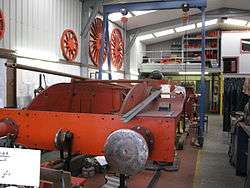 |
Stored or on display
[8]
| Origin |
Wheel
arrangement |
Class |
Notes |
Photograph |
| Manning Wardle |
0-6-0ST |
|
No 641 Sharpthorn. Built in 1877. Arrived at Bluebell 1982. Used by the contractors in the building of the original Lewes and East Grinstead Railway (now the Bluebell Line) in the early 1880s. On static display at Horsted Keynes Station. As of August 2014, a cosmetic restoration is in progress.[9] |
.jpg) |
| LB&SCR |
0-6-0T |
A1 |
No 672 Fenchurch. Built in 1872. Arrived at Bluebell 1963. Returned to traffic in 2001 after a rebuild. This engine was withdrawn at the end of January 2011 following expiry of its boiler certificate and overhaul is not likely any time soon given the large number of small tank engines currently in service. Overhaul is expected to start after P-class No.27 is completed, with an ambition to return the locomotive to steam for the 150th anniversary of her construction in 2022. |
 |
| LB&SCR |
0-6-0T |
A1 |
No 55 Stepney. Built in 1875. Seen by many as the flagship of the fleet, as the first locomotive to be permanently based on the line in May 1960. The engine was relaunched into traffic in time for the 50th Anniversary of his arrival on the line on 17 May 2010, emerging in the black livery he wore during the 1960 season. The engine requires a full overhaul at some point in the future, including a new cylinder block. Withdrawn from service in March 2014 after his main steam pipe failed. He has recently been cosmetically restored back into LB&SCR improved engine green livery. The engine has been known for starring in the famous children's TV show Thomas & Friends |
 |
| LSWR |
0-4-0T |
B4 |
No 96 Normandy Built in 1893. Arrived at Bluebell 1978. Boiler ticket expired in 2006. Funds are now being raised by the owning society, and it is hoped that any overhaul may commence after 34059 Sir Archibald Sinclair is complete and the good condition of the loco is established. Owned by the Bulleid Society.[10] The need for this locomotive has become less with the acquisition of a small diesel locomotive for shunting duties and the use of other tank engines for the steam shunts. |
 |
| LSWR |
4-4-2T |
0415 |
No 488. Built in 1885. Arrived at Bluebell 1961. On display at Sheffield Park. Work on this engine is unlikely to commence for some time. The locomotive is thought to require at least a new boiler barrel (if not a new boiler entirely) and possibly new wheels, which given the unique nature of the locomotive will be an expensive undertaking. |
 |
| NLR |
0-6-0T |
Class 75 |
No 58850. Built in 1880. Arrived at Bluebell 1962. Last worked in 1993 & is awaiting overhaul. Was on display at Barrow Hill Roundhouse until 2006, when it was moved back to the Bluebell with a view to a quick overhaul to replace 96. However, with the work required being more extensive than originally thought, it has yet to receive any major attention. The overhaul will require a new firebox to be fitted. |
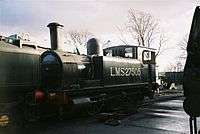 |
| LB&SCR |
0-6-2T |
E4 |
No B473 (formerly known as Birch Grove). Built in 1898. Arrived at the Bluebell in 1962. B473 returned to service in January 2010 in 1920s Southern Railway livery following overhaul. The locomotive returned to service in August 2014 after repairs to the firebox were completed using Radweld. However in 2016 the same firebox fault occurred and the repair cannot be repeated so the decision was made to withdraw B473 from service even though the Boiler ticket expires in 2019. The next overhaul will require major replacement of copper plates forming the inner firebox. |
.jpg) |
| GWR |
4-4-0 |
3200 |
No 9017 Earl of Berkeley Built in 1938. Arrived at Bluebell 1963. Returned to traffic in November 2003 after an overhaul which included a number change from 3217. The condition of the firebox saw this locomotive withdrawn in June 2011 two years before the expiry of her boiler ticket. This locomotive has been considered as the next medium-sized locomotive to be overhauled, the extensive work carried out during the previous overhaul rendering this a relatively straightforward job. Her tender was loaned to the Gloucestershire Warwickshire Railway in 2014 for use behind GWR 7800 Manor Class No. 7820 Dinmore Manor until the overhaul of that is completed. |
 |
| SR |
2-6-0 |
Maunsell U class |
No 31618. Built in 1928. Arrived at Bluebell 1977 from the Kent & East Sussex Railway. Last worked in 1994 and is on static display awaiting a 10-year overhaul. Its tender was loaned to the Watercress Line in 2010 as a replacement for classmate 31806's, which was heavily damaged in a fire at Ropley. The tender was returned to the Bluebell in mid-2011, 31806's having been repaired. 31618 has been painted in lined BR black to match the tender, and to smarten the appearance of the engine up after many years in the shed. The overhaul is not likely to start until the work has been completed on 928, and even then 1638 may be given priority. |
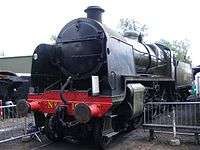 |
| SR |
2-6-0 |
Maunsell
U Class. |
No 1638. Built in 1931. Arrived in 1980. Returned to service for the first time in 42 years in February 2006. The boiler ticket expired in January 2016, but due to a number of minor faults and the need for a new hydrauic test, it was decided to withdraw it from service in July 2015. 1638 has been a reliable performer over the last nine and a half years, although requiring a couple of spells in the works for boiler and firebox repairs, and has borne the brunt of the heavier services on the Bluebell over its period in service. |
 |
| SR |
0-6-0T |
USA Class |
No 30064. Built in 1943. Arrived at Bluebell 1973. Withdrawn 1983. Painted in WD grey. Currently on static display awaiting overhaul, with no imminent plans to return her to steam. 30064 was moved to Horsted Keynes to make way for the Woodpax project. The loco will need several modifications to make it run again, and is thought to be an unlikely contender due to an apparent propensity to damage the track. |
 |
| SR |
4-6-2 |
West Country |
No 21C123 Blackmoor Vale. Built in 1946. Arrived at Bluebell 1971. Returned to traffic in 2000. Withdrawn two years early in June 2008 following repeated failures and firebox problems, and is currently out of ticket awaiting overhaul. A new firebox will be needed at the locomotive's next overhaul, which should cost around £150,000. The locomotive's owners, the Bulleid Society, have purchased new thermic syphons, as the first stage in obtaining the components for this work. A new inner firebox will also be constructed alongside that for 34059. She is currently stored at Horsted Keynes. |
 |
| BR |
4-6-0 |
Standard Class 4 |
No 75027. Built in 1952. Arrived at Bluebell 1969 as the Bluebell's first "large" engine. Withdrawn February 2007, shortly before the expiry of her boiler ticket, following a number of small failures. The engine is currently on display at Horsted Keynes while awaiting overhaul to free up space at Sheffield Park. |
 |
| BR |
2-6-4T |
Standard Class 4 |
No 80064. Built in 1953. Arrived at Bluebell 1984. Last ran in 1991 and awaiting a heavy overhaul. The main thing that has prevented its overhaul is the need for copper welding in the firebox. However, there is a chance for it to go in after 80151, for the required copper welding may become possible in-house on the Bluebell, making the overhaul more feasible. The locomotive is not owned by the Bluebell, and as such any work undertaken would need to be organised with them. |
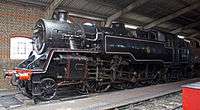 |
| BR |
2-6-4T |
Standard Class 4 |
No 80100. Arrived at Bluebell 1978. Awaiting major restoration to Barry Scrapyard condition. Unlikely that a start will be made on restoration in the foreseeable future, at least until 84030 enters traffic. The locomotive is currently stored in the carriage shed at Sheffield Park in order to provide some protection from the elements. |
 |
| BR |
2-10-0 |
9F |
No 92240. Built in 1958. Arrived at Bluebell 1978. Withdrawn in December 2002 due to deteriorating tubes. This locomotive, along with 75027, was moved to Horsted Keynes for display in early 2010 to allow space at Sheffield Park to be used to store stock during work on the Woodpax project. There are no plans for an imminent return to steam, the locomotive currently being stored at Horsted Keynes. If overhaul were to start soon, it would likely take only a short time to complete given the good mechanical condition of the locomotive. |
 |
Bluebell locomotives based elsewhere
[11]
| Origin |
Wheel
arrangement |
Class |
Notes |
Photograph |
| Avonside |
0-6-0 |
|
No 24 Stamford. Built in 1927. Arrived at Bluebell 1969. Based since 1998 at the Rutland Railway Museum. As an engine which doesn't fit in with the rest of the Bluebell collection, return is unlikely in the immediate future. |
|
Diesel locomotives
On loan
| Origin |
Wheel
arrangement |
Class |
Notes |
Photograph |
| British Rail |
0-6-0 |
Class 09 |
No 09018. Bought by a consortium of locomotive department volunteers, 09018 is on loan to the railway on an "at-cost" basis where the railway hires it until the members receive their funds back. The higher gearing of an 09 compared to an 08 allows it to be used in emergencies on passenger services at 25 mph, a role it undertook for the first time during summer 2013. |
 |
Operational
| Origin |
Wheel
arrangement |
Class |
Notes |
Photograph |
| Sentinel |
B |
|
Works no. 10241 and built in 1966, although technically built after the company became Rolls Royce owned. The locomotive was rebuilt by Thomas Hill in 1973 following accident damage.[12] This engine was acquired by the Bluebell in 2010 as a replacement for a hired-in class 08, for use primarily as the Horsted Keynes carriage works shunter. This is the first diesel locomotive ever to be owned outright by the railway, and is known by Bluebell volunteers as 'Skippy'. |
 |
| Howard |
B |
Class 2 |
No 957, petrol-engined locomotive. The restoration, the longest running on the railway, of the locomotive was completed thanks to the Alf Brown group. The locomotive was run for the first time at the 50th Anniversary celebrations in August 2010. |
 |
Electric motive power
Stored or on display
| Origin |
Class |
Notes |
Photograph |
| British Rail |
423 |
4-Vep unit 3417 "Gordon Pettitt" is currently undergoing restoration by Bombardier Traction apprentices at their Ilford depot. The unit is currently on loan to the Southern Electric Traction Group, who intend to operate it on the national rail network once its restoration is complete. The unit was stored at Clapham Junction for some time prior to the move to Ilford, and has operated over Bluebell metals with a class 73 on special shuttle services between East Grinstead station and the railhead at Imberhorne tip. |
 |
Carriages
[13]
4- and 6-wheeled coaches
The eventual plan is to put together two complete 4- or 5-coach sets of LBSCR and LCDR carriages. It is acknowledged that this will take many years, but three carriages are already in service with another three under overhaul. Most of these carriages have been rescued as grounded bodies from within bungalows or on farms. Underframes for many of them are (or will be) provided by shortening SR passenger-rated van underframes.
| Origin |
Number |
Type |
Notes |
Photograph |
| LCDR |
48 |
6-wheeled Brake |
Built in 1894. Stored awaiting major restoration, but the underframe has received some attention. This coach was formerly used as a break room. Unlike any other preserved LCDR six-wheelers, its original six-wheeled chassis is still intact, and deemed eminently restorable. |
|
| LCDR |
114 |
4-wheeled Brake Third |
Built in 1899. Returned to traffic in 2006 after an extensive restoration; was previously used as a bungalow. In use with the other 4-wheelers. |
 |
| LCDR |
51 |
4-wheeled Brake Second |
Built in 1889, basically identical to 114. In 2009 the carriage gained public support in an appeal on national television for funds toward overhaul, including provision for disabled passengers, something at the time unavailable on the line's vintage trains. It has now entered service in use with the other 4 wheeled coaches, painted in SECR livery as 3360. |
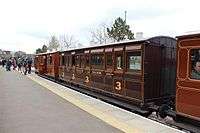 |
| LCDR |
668 |
6-wheel Third |
Built in 1897. Returned to service on the 25th June 2016 following restoration. This was a grounded body, and has been mounted on a two-axle underframe. The end result provides a carriage similar to other ex-LCDR six-wheelers used on the Isle of Wight by the SR. The carriage has been painted in SECR livery to match 3360 and numbered 3188. |
 |
| LBSCR |
661 |
Stroudley 4-wheel First |
Built in 1880. In use. It is planned to eventually be part of a Stroudley train. |
 |
| LBSCR |
676 |
Stroudley 4-wheel Brake Third |
Built in 1875. Stored awaiting restoration |
|
| LBSCR |
949 |
Stroudley 4-wheel Brake Third |
Built in 1881. Undergoing restoration, a new underframe has been found and the structure is complete. The carriage has been reassembled externally and is awaiting painting and varnishing as well as the interior rebuilding. |
 |
| LBSCR |
328 |
Stroudley 4-wheel Third |
Built in 1890. Moved into the works in early 2010. The underframe has been refurbished and work on reconstructing the bodywork is underway. |
 |
| LBSCR |
992 |
Stroudley 4-wheel Third |
Built in 1880. Stored awaiting restoration. |
|
| LBSCR |
35 |
Craven 4-wheel Second |
Three compartment carriage built in 1856. Stored awaiting restoration.[14] Work is planned to start once the other 4-wheel Stroudley carriages are finished. |
|
| LBSCR |
94 |
Craven 4-wheel Full Brake |
Built in 1858. Stored awaiting restoration.[14] |
|
| LBSCR |
221 |
Craven 4-wheel Brake Third |
Built in the early 1850s (1850–52) as a Luggage Brake Second and later downgraded to a Brake Third. Withdrawn from service by 1888 and sold c1901. Salvaged from a house in Battle on 26 August 2009.[14] Awaiting restoration. In July 2011, this carriage was seriously damaged by fire. |
|
| LBSCR |
204 |
Craven 4-wheel Quadrant-windowed First |
Three compartment carriage built in 1866. Stored awaiting restoration. |
|
| LSWR |
25 |
6-wheeled 34-ft Family Saloon |
Built in 1885. Stored awaiting restoration. |
|
| SER |
172 |
6-wheeled Saloon |
Built in 1898. Stored awaiting restoration. |
|
Pre-grouping bogie coaches
The operational coaches of this type form a set of coaches which have operated over recent years as the Bluebell's regular Vintage set. The Bluebell possesses one of the largest collections of these types of carriage in the world.
| Origin |
Number |
Type |
Notes |
Photograph |
| LBSCR |
142 |
Bogie First |
Built in 1903. Returned to traffic in 1999 and won the 'Best Coach of the Year' award for 2002/03. After some time awaiting tyre turning, the coach has now returned to regular service. |
 |
| LSWR |
320 |
Lavatory Third |
Built in 1900. Stored undercover, expected to be one of the next carriages to be overhauled. |
|
| LSWR |
494 |
Corridor Third |
Built in 1911. Stored awaiting restoration. |
|
| LSWR |
1520 |
Brake Third |
Operational. Built in 1910. The carriage was relaunched into traffic in April 2010 following major rebuild from departmental use. The carriage has been finished in LSWR livery so that it only sees limited use as it doesn't match other carriages of a similar vintage. |
 |
| SECR |
971 |
Hundred Seater |
Built in 1923. Withdrawn from traffic in 2007 for what was hoped to be a quick overhaul. Examination revealed a much heavier amount of work was required on the carriage's side panels and underframe, as well as a need to replace rotted sections of the roof and internal partitions, as well as re-trimming of the seats. The carriage is currently in store awaiting restoration. |
 |
| SECR |
1061 |
Birdcage Brake |
Built in 1909. Stored awaiting restoration. |
|
| SECR |
1084 |
Birdcage Brake |
Operational. The carriage returned to traffic in November 2011 following rebuild. |
 |
| SECR |
1098 |
Hundred Seater |
Built in 1922. Operational. The carriage is popular among many visitors to and members of the line. |
.jpg) |
| SECR |
1170 |
Birdcage Brake |
Built in 1912. Awaiting restoration with the roof requiring major attention. The interior will need to be reconstructed from scratch, but fortunately this is fairly plain and should be straightforward. |
|
| SR |
1050 |
Bogie Third |
Stored awaiting overhaul, Included in this section because it was formed in 1924 by the rebuilding of several old SER carriage bodies onto a new bogie underframe. Is being considered for overhaul. |
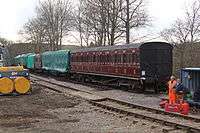 |
Metropolitan carriages
Four carriages built in 1898 and 1900 for use out of Baker Street station in London. Initially steam hauled, later used in electric trains, reverting to steam haulage on the Chesham branch in 1940. Purchased by the Bluebell Railway in 1961, and used until withdrawn in the late 1960s in need of major attention. Now returned to service and are unique as a close-coupled set of vintage carriages. The restoration team were the recipient of the Heritage Railways Association's award as overall winner of their 2006/7 carriage competition. The carriages have seen regular use on London Underground in recent years as part of steam operations on the Metropolitan Line, and possess TOPS identities for movements over the Network Rail network to and from London.
| Origin |
Number |
Type |
Notes |
Photograph |
| Metropolitan |
394 |
Full Third |
Built in 1900. Returned to traffic in 1999. Received major rebuilding to remove the driving cab added in the 1930s when the set was converted to electric operation. |
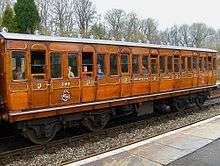 |
| Metropolitan |
368 |
Composite |
Built in 1898. Returned to traffic in 2002. In the 1960s it was the first of the four to suffer from a leaking roof, and was withdrawn from service. A start was made on dismantling it, with the idea being to use the underframe for a rail-carrier. Consideration was given to burning it as a publicity stunt to raise funds for a new carriage shed. However the body, riddled with dry rot, survived, being stored in the dry once the carriage shed was built in 1972, so saving the vehicle for its eventual restoration. |
 |
| Metropolitan |
412 |
Composite |
Built in 1900. Returned to traffic in late 2006. |
 |
| Metropolitan |
387 |
Brake Third |
Built in 1898. Returned to traffic in 1999. As with 394, the driving cab installed later had to be removed during restoration to return the set to as-built condition. |
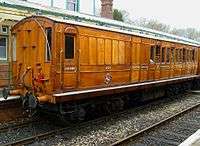 |
Maunsell coaches
The carriages designed by Richard Maunsell for the Southern Railway had a restrained elegance. In preservation terms they provide a superb vintage experience for the passenger, whilst as corridor vehicles they also offer access to more modern facilities. In addition to those preserved on the railway, the Bluebell also has the underframe of coach 3725 and the bogies from several other coaches that were converted to Carflat wagons in the 1960s. For more information see SR Maunsell carriage
| Origin |
Number |
Type |
Notes |
Photograph |
| Maunsell |
1309 |
Open Third |
Built in 1935. In service and used on passenger trains. This coach is unique in preservation, and was restored from stripped-out departmental condition, in part thanks to parts stripped from identical No 1306 when the latter was in a scrap yard. On restoration in 1984 it won the first ever ARPS (now HRA) "Coach of the Year" award. |
 |
| Maunsell |
1336 |
Open Third, "Drop Light" |
Built in 1933. In service and used on passenger trains, having been restored from stripped-out ex-departmental condition. |
 |
| Maunsell |
1365 |
Composite Dining Saloon / Open Third |
Built in 1927. Stored awaiting overhaul after being used on passenger trains regularly in the 1970s. |
|
| Maunsell |
2356 |
Corridor Third |
Built in 1931. Awaiting overhaul, was used for some years as the Carriage and Wagon Department Mess Coach. Overhaul possible in the future. |
|
| Maunsell |
3687 |
Corridor Brake Third |
Built in 1931. Undergoing overhaul and conversion back to original condition, after a BR rebuild and subsequent departmental conversion. The interior is nearing completion and the doors have had all their timberwork overhauled and fitted. |
|
| Maunsell |
3724 |
Corridor Brake Third |
Built in 1930. Stripped out and rebuilt for use on Chipmans weed-killer train. Stored awaiting restoration, following use as an exhibition vehcile. During its eventual restoration it may be converted into a wheelchair-accessible coach on passenger trains. |
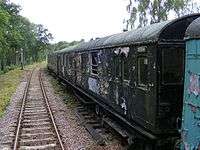 |
| Maunsell |
4441 |
Unclassed Brake |
Built in 1933. Awaiting overhaul with a seriously damaged underframe but a reasonably complete body. It's planned to swap underframes with 4444 in the fullness of time, so this one can be restored. |
|
| Maunsell |
4444 |
Unclassed Brake |
Built in 1933. Out of service awaiting restoration. Its body was affected by dry rot before it arrived on the Bluebell, and this has not been completely eliminated. It's planned that 4444 will donate its underframe to 4441, the body being in better condition. |
|
| Maunsell |
4922 |
Travelling Post Office |
Built in 1939. Stored awaiting restoration but it has been given low priority as it's not a passenger carrying vehicle. TPO 4922 was purchased in 1977 on the merit of having a complete interior and was restored to running order in 1980. However the paint failed to adhere to the galvanising, and so 4922 was placed in storage in 1984.[15] |
|
| Maunsell |
5644 |
Corridor Composite |
Built in 1930. Stored awaiting restoration. Purchased in 1989 from Chipmans as part of CWT Set 8. This carriage has had its roof recovered but it was found the previous roof covering had been damaged and allowed water ingress. The carriage will require replacement cant rails and eradication of dry rot as part of its restoration.[16] It's considered to be one of the gems of the Bluebell's Maunsell fleet. |
|
| Maunsell |
6575 |
Corridor Brake Composite |
Built in 1929. Stored awaiting a fairly major overhaul particularly at the brake end. The carriage was repainted into Bluebell Blue livery to be partnered with Stepney as part of the 50th Anniversary celebrations. This carriage also featured in a limited edition Hornby pack bought out for the 50th Anniversary. |
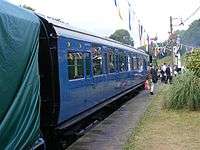 |
| Maunsell |
6686 |
Corridor Brake Composite |
Built in 1935. Operational, won the 'Highly Commended Coach of the Year' award for 1998/99. |
.jpg) |
| Maunsell |
7864 |
Kitchen Buffet |
Built in 1932. Stored undercover. Will be one of the next coaches to be restored as it will go some way toward creating a set available for regular use with the Maunsell locomotives. |
|
Bulleid carriages
The 1940s Southern Railway designs of Oliver Bulleid produced a very clean, modern-looking carriage, many of the features of which were perpetuated in the BR standard (Mk. I) designs. The Bluebell's collection contains examples of SR built, contractor built and BR built carriages. It is unfortunate that none of the shorter, early Bulleid designed carriages have survived.
| Origin |
Number |
Type |
Notes |
Photograph |
| Bulleid |
1456 |
Open Third |
Built in 1947. On loan to the Mid Hants Railway until 2037 where it is being restored to operational condition. |
 |
| Bulleid |
1464 |
Open Third |
Built in 1950. In service and used on passenger trains. |
 |
| Bulleid |
1481 |
Open Third |
Built in 1950. Out of service awaiting a fairly major overhaul with the body structure needing attention and replacement of external paneling. |
|
| Bulleid |
1482 |
Open Third |
Built in 1950. In service and used on passenger trains. |
 |
| Bulleid |
2515 |
Semi-Open Brake Third |
Built in 1951. Awaiting major underframe overhaul. Could be back in traffic quickly as body itself is sound. |
 |
| Bulleid |
2526 |
Semi-Open Brake Third |
Built in 1951. In service and used on passenger trains. |
 |
| Bulleid |
4227 |
Semi-Open Brake Third |
Built in 1948. Awaiting restoration. |
|
| Bulleid |
4279 |
Semi-Brake Open Third |
Built in 1949. Stored awaiting overhaul. |
 |
| Bulleid |
5768 |
Corridor Composite |
Built in 1947. In October 2009 the carriage began to receive a major overhaul which will include work on the bodywork and floor.[17] Owned by the Bulleid Society.[18] This carriage is owned by the Bulleid Society, and is the only surviving loco-hauled Bulleid-design carriage with first class accommodation. |
 |
British Railways standard steam stock (Mk.I)
The staple of most preserved railways, on the Bluebell Mk1s only form a proportion of the operational stock. They are a durable design, representing in many ways the culmination of traditional carriage design in the UK, prior to the introduction of monocoque techniques.
| Origin |
Number |
Type |
Notes |
Photograph |
| British Railways |
1674 |
Restaurant Buffet (Refurbished) |
Built in 1961. Currently in service as part of the Lounge Car Service. |
 |
| British Railways |
1818 |
Restaurant Miniature Buffet |
Built in 1960. Having run on the Bluebell for 30 years, it is currently receiving a re-wire, internally stripped for general overhaul of seating and fittings. |
 |
| British Railways |
1838 |
Restaurant Miniature Buffet |
Built in 1959. In service and used on passenger trains. |
 |
| British Railways |
3064 |
Open First |
Built in 1955. In service and used as part of the Lounge Car Service.[19] |
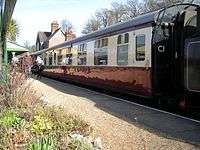 |
| British Railways |
4754 |
Open Second |
Built in 1957. Awaiting Overhaul, which is intended to start once 21246 is complete. Formerly used by the Bicester Military Railway, this carriage was acquired from the Ministry of Defence in 2014. The intention is that once 4754 has entered traffic, the more modern-looking 4957, which is in need of refurbishment, will be offered for sale. |
|
| British Railways |
4824 |
Open Second |
Built in 1959. In service and used as part of the Lounge Car service.[19] |
 |
| British Railways |
4941 |
Saloon |
Built in 1962. In service and used on passenger trains. Converted to multi-use saloon with wheelchair lifts. |
|
| British Railways |
4957 |
Open Second |
Built in 1962. In service and used on passenger trains, but only when the railway needs the additional seating capacity. This is due to the inferior quality of the interior compared to other carriages, which is a result of it having been refitted to serve as a classroom on The Travelling College in the late 1980s. The intention is that once 4754 has entered traffic, this coach, which is in need of refurbishment, will be offered for sale. |
 |
| British Railways |
5034 |
Saloon |
Built in 1962. In service and used on passenger trains. Converted to multi-use saloon with wheelchair lifts.
This carriage had been employed as a dormitory coach on The Travelling College. |
 |
| British Railways |
16012 |
Corridor Composite |
Built in 1957. In service and used on passenger trains. |
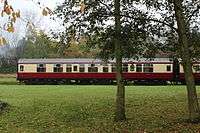 |
| British Railways |
16210 |
Corridor Composite |
Built in 1961. In service and used on passenger trains. |
 |
| British Railways |
21246 |
Brake Composite |
Built in 1962. Under Restoration |
|
| British Railways |
21271 |
Brake Composite |
Built in 1964. Awaiting restoration |
 |
| British Railways |
25728 |
Corridor Second |
Built in 1961. In service and used on passenger trains. |
 |
| British Railways |
25769 |
Corridor Second |
Built in 1961. In service and used on passenger trains. |
 |
| British Railways |
34556 |
Brake Corridor Second |
Built in 1955. In service and used as part of the Lounge Car service. |
 |
| British Railways |
35207 |
Brake Corridor Second |
Built in 1958. In Service. |
 |
Pullman and Wagon-Lits cars
Several of these have been overhauled and operate regularly as the Bluebell Railway's Golden Arrow dining train (lunch and dinner).[20]
| Origin |
Number |
Name |
Type |
Notes |
Photograph |
| Pullman Car Company |
89 |
Constance |
Kitchen First |
Originally SER Drawing Room Car No.33, of 1891, becoming a Pullman in 1919. This car was sold to a private owner who had the carriage body cut in two and integrated into a building before being sold to the Bluebell in 1997. The two halves are in good condition and the remains of Constance are currently stored on the underframe of a Bulleid coach. |
|
| Pullman Car Company |
157 |
Car No. 54. |
Brake Third |
Built in 1923. Undergoing restoration. Car No. 54 was originally preserved on the Dart Valley Railway before moving to the Birmingham Railway Museum in 1970. It was later sold to Venice-Simplon Orient Express and was stripped at Carnforth before being put aside for sale. This car was purchased in 1984 but didn't arrive until 1986. Largely complete, Car No. 54 also contains a large collection of bog doors from the VSOE Pullmans.[21] |
 |
| Pullman Car Company |
175 |
Fingall |
Kitchen First |
Built in 1924. Operational. |
 |
| Pullman Car Company |
219 |
Car No. 64 |
Parlour Third |
Built in 1928. Operational. Named Christine by the railway. Formerly part of the Bulmers Cider Pullman set, but sold to the Bluebell by VSOE as it was a third-class car. This coach was overhauled at VSOE's Stewarts Lane workshops in 2004, and returned to service in 2006. |
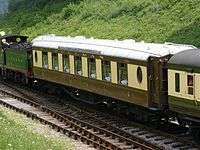 |
| Pullman Car Company |
229 |
Car No. 76 |
Parlour Third |
Built in 1928. Withdrawn for overhaul. Named Lilian by the Bluebell. |
 |
| Pullman Car Company |
307 |
Carina |
Kitchen First |
A 1951 'Festival of Britain' Golden Arrow Pullman carriage. Carina was part of Sir Winston Churchill's funeral train in 1965, and was later sold to the Hotel Mercure in Lyon, France before being returned to the UK in the late 1970s by Venice-Simplon Orient Express. She was originally purchased by the Brighton Belle trust, but was swapped for car Doris which was based for a while on the Bluebell. |
|
| Compagnie Internationale des Wagons-Lits |
3801 |
N/A |
First Class Sleeping Car |
Built in 1939. Car 3801 was part of the last Night Ferry service in 1980. It was stored at Ostend until 1984 when it was purchased by the Bluebell for use as an accommodation coach at Horsted Keynes. It's somewhat unusual but fits in with the Bluebell as this car was formerly used by the Southern Railway and more latterly British Railways (Southern Region). |
 |
Observation car, Royal and Directors' saloons
The Observations cars are occasionally brought out for a ride in. They provide a unique view of the railway and are either attached to the back of a passenger train or used on their own.
| Origin |
Number |
Type |
Notes |
Photograph |
| GNR |
706 |
Directors' Saloon |
Built in 1897. In traffic and is used fairly regularly on passenger trains on Bank Holidays and the summer months, as well as at special events. Owned by the Howlden Trust. |
 |
| LNWR |
1503 |
Observation Coach |
Built in 1913. Painted in LNWR livery. Operational following a rebuild in 2014. |
 |
| LBSCR |
60 |
Directors' Saloon |
Built in 1913. Stored awaiting restoration under a waterproof cover. Work is unlikely to commence for some time with general purpose carriages preferred. |
 |
Non-passenger coaching stock
The Bluebell has a large collection of wagons which were originally used in passenger trains. This section also includes carriages used for service purposes by the Bluebell that were originally passenger carriages.
Pre-grouping vans
| Origin |
Number |
Type |
Notes |
Photograph |
| LCDR |
1 |
Horse Box |
Built in 1882. Destroyed by fire in 2010, may be reconstructed at some point in the future |
|
| SECR |
153 |
Passenger Luggage Van |
Built in 1922. Serviceable, but used as mess van. |
 |
| LBSCR |
270 |
Milk / Fruit Van |
Built in 1908. Overhaul completed in 2015, restored to as-built condition. This vehicle, hualed by Fenchurch, was the last to arrive on the Bluebell via. the line through Ardingly. |
 |
| SECR |
719 |
Birdcage Brake Van |
Built in 1905. Awaiting restoration. |
|
| LSWR |
5498 |
Ventilated Luggage Van |
Built in 1920. Awaiting restoration. |
|
Southern Railway vans, etc
| Origin |
Number |
Type |
Notes |
Photograph |
| SR |
C 404 |
4-wheel brake Van |
Built in 1937. Operational |
 |
| SR |
C 419 |
4-wheel Brake Van |
Built in 1937. Operational |
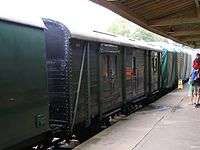 |
| SR |
C 442 |
4-Wheel Brake Van |
Built in 1937. Dismantled. Converted to generator truck in 1990s for Queen of Scots accommodation, and used on the Bluebell as a passenger brake, it was stored out of use at Kingscote where its condition deteriorated to a point where it became the worst of the Bluebell's 4 vans, it was then taken to Horsted Keynes where its body was broken up, with re-usable parts being stored to help maintain the remaining vans. Its underframe will be used to support the body of an 1800s 4-wheel coach. |
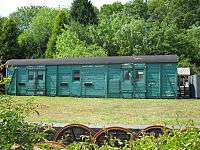 |
| SR |
1184 |
PLV (Passenger Luggage Van) |
Built in 1935. Non operational. Used as a workshop by the S&T Dept. |
 |
| SR |
1788 |
PLV (Passenger Luggage Van) |
Built in 1942. Non operational. |
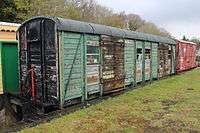 |
| SR |
2186 |
PLV (Passenger Luggage Van) |
Built in 1934. Nearing the end of repairs. |
 |
| SR |
2276 |
Van U (Covered Carriage Truck) |
Built in 1929. Non operational. Used as a workshop for the S&T Dept. |
|
| SR |
2462 |
GBL (Gangwayed Bogie Luggage van) |
Built in 1931. Operational |
 |
| BR |
2531 |
CCT (Covered Carriage Truck) |
Built in 1955. Non operational, used as a store by the Camelot Locomotive Society at Kingscote station. |
 |
| BR |
4601 |
GUV Bogie Scenery Van
(modified for carrying circus elephants). |
Built in 1949. Undergoing restoration. The vehicle is currently being converted into a children's play carriage. |
 |
LMS & BR
| Origin |
Number |
Type |
Notes |
Photograph |
| LMS/BR |
398 |
First Sleeper |
Built in 1952. Non operational and used as a staff sleeping accommodation. |
 |
| LMS/BR |
603 |
Third Sleeper |
Built in 1951. Non operational and used as a staff sleeping accommodation. |
 |
| LMS/BR |
623 |
Third Sleeper |
Built in 1952. Non operational and used as a staff sleeping accommodation. |
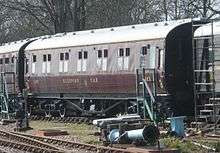 |
| LMS |
32975 |
BGZ (6-wheel Gangwayed Guard's Brake, Stove R) |
Built in 1938. Used as a combined kitchen and brake vehicle for the Golden Arrow dining train. Has been fitted with shelving for crockery and facilities to keep food warm, and has been repainted from the familiar LMS crimson livery into Pullman chocolate and cream livery to complement the other vehicles in the rake. The work has been done in such a way that the changes can later be reversed, once a further Pullman vehicle has been overhauled to undertake these functions. |
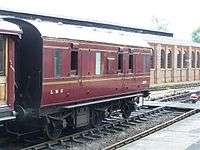
 |
| BR |
6334 |
BG (Full Brake) |
Built in 1957. Non operational and used as a store. |
 |
| BR |
86722 |
Bogie GUV (General Utility Van) |
Built in 1959. Non operational and used as a store. |
 |
| BR |
87720 |
Insulated Fish Covered Van |
Built in 1960. In storage awaiting overhaul which is expected to be done in the coming years. |
|
| BR |
94181 |
CCT (Covered Carriage Truck) |
Built in 1959. Non operational, used as a store by the Howlden Trust at Horsted Keynes. |
|
Mk. I carriages used for non-traffic purposes
| Origin |
Number |
Type |
Notes |
Photograph |
| BR |
2442 |
Staff Sleeping Coach |
Built in 1961. (88 Service Car No.2) Ex-SLC. |
|
| BR |
25776 |
Staff Dormitory |
Built in 1961. (TCL 99166) Ex-SK. |
|
| BR |
25871 |
Carriage Shop at Horsted Keynes. |
Built in 1962. (TCL 99161) Ex-SK. |
 |
| BR |
35419 |
Visitor facilities, East Grinstead. |
Built in 1963. (BDC 977166) Ex-BSK. Converted to form part of the permanent Bluebell presence in East Grinstead, and now provides both a coffee shop / buffet and travel centre at the station. |
 |
Milk tanks
| Origin |
Number |
Type |
Notes |
Photograph |
| United Dairies |
4430 |
6-wheel glass-lined Milk Tank |
Built in 1933. Operational and used regularly in goods trains, and sometimes in passenger trains. Is through-piped for vacuum braking and carriage heat to enable use in standard passenger workings. |
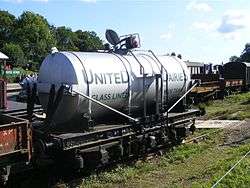 |
Goods wagons
[22]
The Bluebell has a large collection of goods wagons. Some are used in demonstration goods trains at various times of the year.
Brake vans
| Origin |
Number |
Type |
Notes |
Photograph |
| LSWR |
5706 |
10 ton "Road Van" Brake Van |
Built in 1898. Stored awaiting a structural restoration |
 |
| SECR |
11916 |
25 ton "Dance Hall" Brake Van |
Built in 1923. Withdrawn pending overhaul. |
 |
| SECR |
11934 |
25 ton "Dance Hall" Brake Van |
Undergoing restoration |
 |
| GWR |
17908 |
20 ton "Toad" Brake Van |
Operational, but normally stored at Horsted Keynes, presumably because it doesn't fit with the rest of the line's stock.[23] |
 |
| MoS (SR design) |
49018 |
25 ton "Pillbox" Brake Van |
Was built in 1942 for the Ministry of Supply during the Second World War by the Southern Railway. Fitted with Vacuum brake. Later entered BR stock. Soon to receive some cosmetic attention, used mainly on engineers trains. It's intended that this van will revert to its BR identity of M360328. |
 |
| SR |
55993 |
25 ton "Pillbox" Brake Van |
Operational. Built in 1930. |
 |
| SR |
56290 |
25 ton "Queen Mary" Brake Van |
Operational, regularly used with engineering trains and brake van rides. Built in 1936. |
 |
| BR |
62864 |
"Shark" Ballast Plough Brake Van |
Stored awaiting restoration. Built in 1949. |
|
Covered goods vans
| Origin |
Number |
Type |
Notes |
Photograph |
| LSWR |
2773 |
10 ton Covered Goods Van |
Stored awaiting overhaul |
|
| LSWR |
8112 |
10 ton Covered Goods Van |
Stored awaiting overhaul |
|
| LBSCR |
8196 |
6 ton Box Van |
In service and used regularly on goods trains |
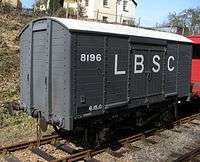 |
| LBSCR |
1590 |
8 ton Box Van |
Stored awaiting major restoration |
|
| SECR |
15750 |
12 ton Covered Goods Van |
In service and used regularly on goods trains |
 |
| SR |
44611 |
10 ton Ventilated Van |
In service and used regularly on goods trains |
 |
| SR |
47588 |
12 ton Ventilated Van |
In service and used regularly on goods trains |
 |
| LMS |
524178 |
12 ton Plywood Ventilated Van |
Awaiting restoration |
|
| LMS |
570027 |
Banana Van |
Servicable, but in need of major external refurbishment. Currently stored at Kingscote awaiting attention. Not a vehicle which fits with much of the rest of the goods train so not a priority. |
 |
| BR |
B772972 |
12 ton Pallet Van |
Stored awaiting restoration |
|
Open goods wagons
| Origin |
Number |
Type |
Notes |
Photograph |
| LSWR |
91 |
3, 4 or 5 Plank Open Goods Wagon |
Awaiting restoration |
.JPG) |
| LBSCR |
3346 |
Hi-Bar Open Goods Wagon |
In service and used regularly on goods trains |
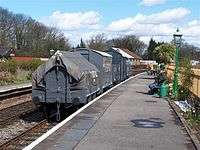 |
| SECR |
5542 |
7 Plank Open Goods Wagon |
In service and used regularly on goods trains |
 |
| SECR |
16194 |
7 Plank Open Goods Wagon |
In service and used regularly on goods trains |
 |
| SECR |
16358 |
7 Plank Open Goods Wagon |
Dismantled for major repairs |
|
| SECR |
50899 |
5 Plank Open Goods Wagon |
Stored awaiting overhaul |
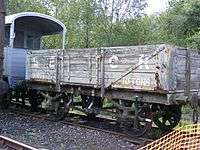 |
| SR |
9608 |
5 Plank Open Goods Wagon |
Servicable but rarely used |
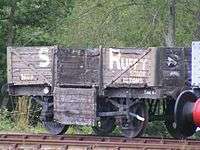 |
| SR |
10013 |
5 Plank Open Goods Wagon |
In service and used regularly on goods trains |
 |
| SR |
12058 |
5 Plank Open Goods Wagon |
Undergoing restoration with the underframe and framework receiving attention, although priority is being given to passenger vehicles. |
|
| SR |
62002 |
5 Plank Open Goods Wagon |
In service and used regularly on goods trains |
 |
| SR |
30004 |
8 Plank Open Goods Wagon |
In service and used regularly on goods trains |
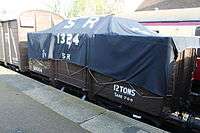 |
| SR |
37786 |
8 Plank Open Goods Wagon |
In service and used regularly on goods trains |
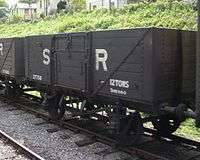 |
| PBA |
59685 |
13 ton Steel Mineral Wagon |
Stored awaiting major restoration |
|
| LMS |
66071 |
5 Plank Open Goods Wagon |
Stored awaiting restoration |
 |
| GWR |
87782 |
5 Plank Open Goods Wagon |
Undergoing restoration. |
|
| LMS |
411245 |
13 ton open merchandise Wagon |
Operational and used regularly on goods trains |
 |
| LMS |
474558 |
3 Plank Open Goods Wagon |
Overhaul completed |
 |
| LMS |
M480222 |
3 Plank Open Goods Wagon |
Overhaul completed |
 |
| BR |
B458525 |
Steel dropside Open Goods Wagon |
Out of service stored at Kingscote |
 |
| BR |
B461224 |
Steel dropside Open Goods Wagon |
Out of service stored at Kingscote |
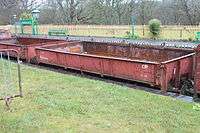 |
| BR |
B741381 |
"Pipefit" dropside Open Goods Wagon |
Out of service stored at Kingscote |
 |
Flat wagons and bolster wagons
| Origin |
Number |
Type |
Notes |
Photograph |
| SR |
39617 |
Motor Car Truck |
Stored at Kingscote. It is hoped that this vehicle can be released for restoration in the near future, subject to workshop space at Horsted Keynes. |
 |
| SR |
57889 |
Bogie Bolster |
Undergoing overhaul |
|
| SR |
57949 |
Bogie Bolster |
Operational |
 |
Tank wagons
| Origin |
Number |
Type |
Notes |
Photograph |
| BP |
4497 |
Class A Shell Tank Wagon |
Stored awaiting overhaul |
 |
| Esso |
1921 |
Class B Tank Wagon |
Operational and used regularly on goods trains. |
 |
| Shell-BP |
1603 |
Class A Tanker |
Emergency Water Supply at Kingscote, was the sole supplier of water north of Horsted Keynes until the opening of the East Grinstead station water column in 2015. Was cosmetically restored by the Friends of Kingscote team in 2014 |
 |
Ballast wagons
| Origin |
Number |
Type |
Notes |
Photograph |
| SECR |
567 |
2 Plank Ballast Wagon |
Operational, and used in demonstration goods trains. Has been contsructed based on the identical underframe of an SECR 7-plank wagon, since the Bluebell had 4 of these, but no 2-planks survived into preservation. |
 |
| SR |
62002 |
Dropside Engineers Wagon |
Fully restored and used regularly on goods trains |
|
| BR |
983103 |
Dogfish Ballast Wagon |
Operational and used in the engineers train |
|
| BR |
984082 |
Grampus Engineers Dropside Wagon |
Operational and used in the engineers train |
 |
| BR |
984506 |
Grampus Engineers Dropside Wagon |
Operational and used in the engineers train |
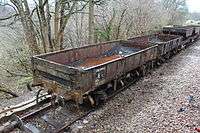 |
| BR |
986419 |
Grampus Engineers Dropside Wagon |
Operational and used in the engineers train |
|
| BR |
986591 |
Grampus Engineers Dropside Wagon |
Operational and used in the engineers train |
 |
| BR |
987403 |
Grampus Engineers Dropside Wagon |
Operational and used in the engineers train |
 |
| BR |
988395 |
Grampus Engineers Dropside Wagon |
Operational and used in the engineers train |
 |
| BR |
991391 |
Grampus Engineers Dropside Wagon |
Operational and used in the engineers train |
 |
| BR |
992780 |
Dogfish Ballast Wagon |
Operational and used in the engineers train |
 |
| BR |
993210 |
Dogfish Ballast Wagon |
Operational and used in the engineers train |
 |
| BR |
993217 |
Dogfish Ballast Wagon |
Operational and used in the engineers train |
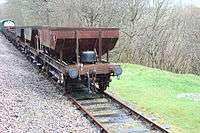 |
| BR |
993348 |
Dogfish Ballast Wagon |
Operational and used in the engineers train |
 |
Cranes and other special use wagons
| Origin |
Number |
Type |
Notes |
Photograph |
| SR |
61107 |
Well wagon |
Used to carry engineering vehicles. Eventually planned to have its BR modifications removed. |
|
| GWR |
100677 |
Sleeper Wagon |
Used to carry sleepers |
 |
| BR |
B904134 |
Lowmac Machinery Wagon |
Stored at Kingscote |
 |
| BR |
B900036 |
Trolley Wagon |
Used to carry smaller locomotive boilers |
|
| BR |
B900920 |
Bogie Well Wagon |
Used to carry locomotive boilers |
|
| LNER |
1083 |
Ransome & Rapier Steam Crane |
Moved to Horsted Keynes after many years stored out of use, for a start to be made on restoration to operational condition in terms of potential use in trains. |
 |
| SR |
1748S |
Joseph Booth & Sons Hand Crane |
Operational. Was used heavily in the 80's and the early 2000s before "working at height" rules really came into force, which have rendered this vehicle rather an H&S hazard. |
 |
References
Further reading
|
|---|
|
| Operational railways |
|---|
| | Narrow gauge | |
|---|
| | Standard gauge |
|
|---|
|
|
|
|
|
|
|
|



.jpg)







.jpg)



.jpg)










.jpg)
.jpg)




































